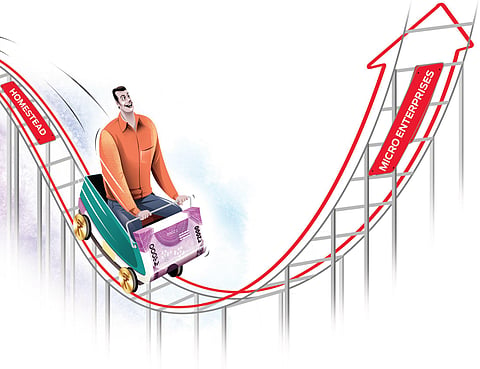

After being impacted severely by the Covid-19 pandemic and recording the worst contraction of its economy in 2020-21, there were high expectations that India’s economy would record a V-shaped recovery during the current year. However, in the three quarters of 2021 for which growth numbers are available, it is evident that sustained growth is still eluding the economy. As a result, the country’s GDP continued to be below the pre-Covid level. The lack of recovery was largely because domestic demand was sluggish, with private final consumption expenditure, the mainstay of GDP, continuing to remain depressed through this phase of recovery.
Although domestic demand remained at a low ebb, the Indian economy was kept buoyed by strong export growth or foreign demand. Imports had bounced back even more, but mainly on account of rising commodity prices. More significantly, India’s trade to GDP level had crossed the 50% mark, the first time it had done so since 2013-14. Given its strong performance, there is every possibility that the current fiscal year will end with trade playing an important growth trigger for the economy.
India’s export performance has never been better than that seen in 2021. In the first 11 months of the year, exports exceeded $354 billion, over $57 billion (or 19.2%) higher than the previous best for the same period, which was achieved in 2019. Imports, too, have touched a record high of $513 billion, almost 9% above the previous high of $472 billion in 2018. Importantly, higher imports could well be the signs that the economy is on-course for a sustained recovery in 2022.
Encouraged by the rapid expansion of exports in the earlier months of the year, the government had set an export target of $400 billion for the fiscal year 2021-22. In the first eight months of the current fiscal (April-November 2021), exports had reached well over $263 billion, exceeding the previous high for this period by almost 22%. Although in November, exports were at their lowest level during this fiscal year, there is every likelihood that the $400 billion target will easily be reached.
India’s exports to most of its major destinations touched record levels during 2021. Exports to the largest destination, the United States, increased by almost a third as compared to the level in 2019 to $58.7 billion. Even more impressive was India’s exports to China, the third-largest destination, where the increase was more than 42% during the same period. Bangladesh emerged in the top five export destinations for the first time; India’s exports to its neighbour increased by over 67% when compared with the 2019 figures. However, exports to the second-largest export destination, namely the United Arab Emirates, declined in the midst of the overall surge.
Backed by this impressive export performance, a confident India is now seeking to forge several free trade agreements (FTAs). This is a complete turnaround from 2019, when India had walked out of the Regional Comprehensive Economic Partnership (RCEP), the mega-regional trade agreement of East Asia.
The first of India’s FTAs could be with the UAE, which was once its largest export destination. However, with the decrease in India’s oil imports, trade with the UAE has lost momentum over the past several years. As the major gateway to the Gulf and, more importantly, the African continent, increase in trade ties with the Arab nation could provide further buoyancy to India’s exports.
India has also begun discussions for a possible FTA with the United Kingdom, which is seeking to overcome the handicap it could suffer in the post-Brexit phase by rapidly forging close trade links with partner countries. Since it left the European Union less than two years back, the UK has already formalised 40 FTAs with its trade partners. It is showing similar urgency to formalise an FTA with India and therefore, the New Year could well see heightened engagement between the two countries for closer trade relations.
The government has also indicated that it would seek to conclude the long-stalled FTA negotiations with the European Union, Australia, Canada and Israel, thus signalling that 2022 could well become the year of FTAs for India.
For several years, speculation has been rife about a possible FTA between the US and India. But the dealings of the Trump administration with India, especially the withdrawal of the GSP preferences that India had enjoyed since the inception of the scheme and the initiation of the tariff war, resulted in a trust deficit that could not be bridged. However, the Biden administration is appearing to be in a conciliatory mood, as was evident from the recent visit of the US Trade Representative, Katherine Tai. This may well be the first steps for a possible FTA between the two countries.
(bisjit@gmail.com)